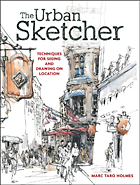Day Twelve : #30x30DirectWatercolor2018 : Montreal’s Paifang
This one felt great to paint. The whole operation was quite smooth. All decisions happened spontaneously without a lot of debate. Sometimes I sit there thinking – omg, should I do this, I’m about to wreck the thing, what if this stroke is too much, bla bla bla. When you’re in the zone, there’s none of that. Your mind is quiet, and the image just appears without conscious thought.
That’s the beauty of being on Day 12. The continuous daily practice really feels good.
Here’s what I did to prepare.
I’ve been having so many false starts this past 12 days – I thought, why not make it official? Do a test painting. A dry run, just throwing it down to feel how it will go. Knowing in advance this one was disposable, I didn’t get annoyed as it got all blotchy and overly contrasty.
I do these tests, or false starts at the same size as the final – 1/4 sheets. Some people might say to do a small study. They’re probably smart. I’m always gambling the study will turn out and become the finish.
Here’s another new aspect – starting with the shadow pattern. Usually, I lay the shadow in on top of a base tone – following the concept of Larger>to>Smaller, Lighter>to>Darker.
This time, I started with a very faint statement of the gate – just a pale pink stain – so I could get the position on the page.
Then washed the sky – very wet in wet – and almost immediately the ground – and this time, I blasted in a honey consistency shadow, while the ground was damp. I think that worked out tremendously well – the shadow is more integrated into the ground than I might sometimes see in one of my sketches.
I think having done the test sketch, I could make the general shadow shape with confidence, kind of knowing already how it should go.
The rest of the painting is calligraphic strokes, getting progressively darker, smaller and thicker (in the mix).
I’m super happy with the clean and direct Large to Small Light to Dark execution.
The wetter than usual (for me) first pass is a nice contrast to the crisp shapes on top.
I did have to wait a long time for the first layer to dry before I could move to details. If I was in a rush I’d paint two at once, so there’s something to do while waiting for washes to dry.
When I’m on a trip I’m always a bit manic – knowing I only have one day on location. Here at home, I can just read for 10 min while things set.








Fascinating paintings and descriptions. I have slowly learned that I cannot paint this directly as you can–even having your well studied book. But I have learned so much from you-Craftsy classes and books–and now from your posts. Sometimes it is difficult to learn not only what works for one but what one enjoys doing. I’m still working on it. Thanks.
Well Judy, never say never – think of it like learning a language or a musical instrument. It takes that kind of time frame. :)
Hi Marc
Yes–this one reflects your faith in the process. Watercolor can be difficult because there is so much that is a result of the paints working their magic on the paper–but your calligraphic strokes bring such liveliness to the painting. Thanks for sharing !
The success of this piece is so very evident of your circumstance and attitude. I appreciate you sharing your thought-process and emotions so openly. . . . something very few people can do convincingly. Your hands ONLY did the painting . . . your brain and approach to your subject did the masterpiece. THANK YOU, once again.
I’ve been following your progress in this 30 x30 and can certainly see how daily practice and patience are needed to improve. Plein air painting is an art in itself! Where to start? … is always a question for me. Thanks for sharing your thoughts and strategies. It really helps to know that other plein air painters have the same challenges. You are an inspiration! Keep sharing